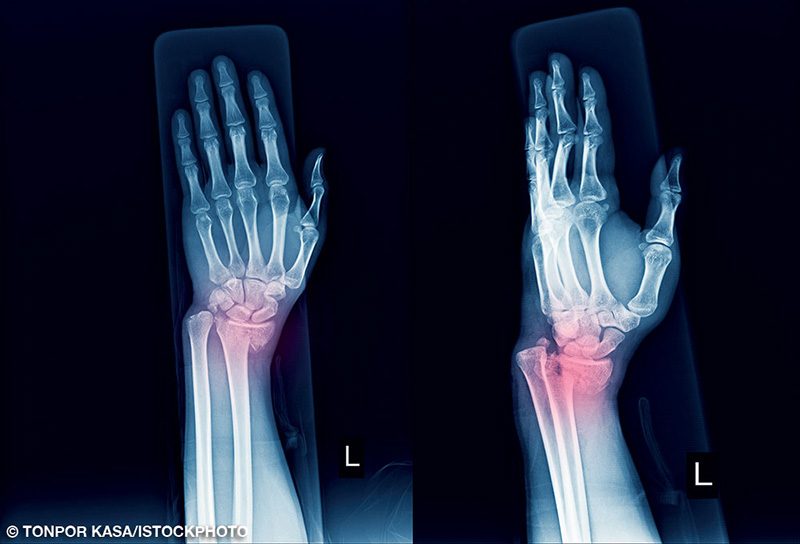DAN® medical information specialists and researchers answer your dive medicine questions.
When I wear a wetsuit in humid conditions, I get dizzy and nauseous; it feels the same as when I have motion sickness, which is a common problem for me. Why does this happen, and what can I do to prevent it?
Neoprene wetsuits retain moisture and heat, which likely leads to your dizziness and nausea. When a diver is fully suited and zipped up, prolonged time on the deck of a dive boat or onshore prior to entering the water can cause heat stress and exhaustion. Common symptoms are dizziness and nausea. Try to avoid fully suiting up until right before you are ready to don your buoyancy compensator and enter the water. Once out of the water after completing your dive, remove your gear and at least the top half of your wetsuit to help your body vent heat. Along with adequate hydration, limiting your time in the sun while in your wetsuit will help prevent heat stress.
— Jonathan Gilliam, EMT-P, DMT
Are there any issues with diving within a few hours of getting a chiropractic adjustment?
There are no studies investigating the relationship between chiropractic adjustments and scuba diving. The possible medical fitness-to-dive concerns would be the underlying need for an adjustment (e.g., lower-back and/or neck pain, headache, etc.) and whether the condition represents any physical or functional impairment that might interfere with dive safety or the ability to respond appropriately to an emergency.

Furthermore, some people might experience complications or side effects for a few days following a chiropractic adjustment. These symptoms can include headache, fatigue, pain and swelling that may appear as shooting radicular pain, or weakness in parts of the body that were treated — all of which could be mistaken for decompression sickness (DCS) and lead to an unnecessary recompression treatment.
Similarly, DCS symptoms could be incorrectly attributed to possible complications or side effects from the adjustment or the underlying condition being treated. While we do not believe there is any physiological association between dive safety and a chiropractic adjustment, we just don’t know. The bottom line is that based on the assumption that the underlying disorder is not a contraindication for diving and the adjustment goes well, it would be wise to allow several days before considering a dive to ensure you are in top condition.
Diving should be a positive experience, so dive with care. DAN is here to answer any questions you or your physician may have about diving and your health.
— Daniel A. Nord, EMT-P, CHT
While on a recent trip to Hawaii, I was swimming off the beach and stepped on sea urchin. I had one large puncture in the area between the big toe and the ball of my left foot and a few smaller ones on my right foot. Initially, my left foot was bleeding, and my right foot was a little painful. As advised by a local lifeguard, I have been soaking my feet in hot water and vinegar. All the black marks are completely gone, but yesterday my left big toe started to become slightly swollen and itchy with no redness or feeling of heat. I can walk but have a noticeable limp, and I have a limited range of motion with my left big toe due to minor swelling. Is this a normal part of the healing process?
Unfortunately, sea urchin puncture wounds are known for being problematic, particularly when involving toes or small joints. When a sea urchin spine puncture involves a joint, promptly seek medical attention at the time of injury. Hot-water immersions might help with the pain but will not be a long-term or definitive solution. Vinegar soaks are known to be a good first aid treatment for jellyfish stings and injuries from other cnidarians but are not useful with sea urchin punctures, which don’t involve cnidocytes.

The minor swelling and limited range of motion of the big toe indicate inflammation, a retained foreign body or an infection. With time an infection might evolve into a granuloma (a mass of immune cells trying to wall off an infection or a foreign body), which will feel like a puffy, firm, red and painful lump. A granuloma that is restricted to the soft tissues typically responds well to antibiotics and corticosteroids, but surgical drainage of that pus may be needed if the granuloma affects a joint space or tendons, particularly when it contains a foreign body that cannot be dissolved or naturally expelled. These chronic inflammatory processes can lead to fibrosis that can limit range of motion. In those cases, physical therapy can can be useful as the treatment itself to minimize fibrosis and restore the range of motion in the affected joint(s).
Unbearable pain while in motion usually suggests that the sea urchin spine has reached a joint. A spine puncture that reaches tendons of the hands and feet can cause tenosynovitis, which is inflammation of the tendons and the fluid-filled sheath that surrounds the tendon. Those cases usually require professional surgical intervention. Neglecting this inflammation could result in permanent damage to the affected joint.
Sea urchin spines are covered by a thin layer of tissues, which appears as a strong pigment in some species. These tissues and pigments are an antigenic mosaic that stimulates a strong immune and inflammatory reaction. This is the reason why many sea urchin puncture wounds can have a torpid evolution that perpetuates for months after the puncture. Time, patience, anti-inflammatories and physical therapy are the key elements for long-term success.
— Travis Ward, EMT-P
I fractured my wrist in an accident on my bicycle last week, and my doctor splinted it with a waterproof cast. I’m leaving on a dive trip this weekend. What issues should I be concerned about when diving?

Diving is not recommended with any fracture regardless of the type of cast. “Waterproof” is a misconception — there isn’t a cast that is truly 100 percent waterproof. Your doctor provided a cast that is approved for showering, bathing and even swimming if done in moderation. Moist skin can become irritated under a cast, causing superficial breaks. The risk of developing an infection from treated or chlorinated water is low, but never zero. Opportunistic microorganisms in salt water and untreated water from sources such as lakes, rivers and quarries exponentially increase the risk for infection. Additional concerns include the decreased functional capacity of the hand and increased risk of further damage from donning and doffing heavy gear and climbing up and down swim ladders. Once the healing is complete and your physician releases you for full and unrestricted activity, diving is not an issue.
— Lana Sorrell, EMT, DMT
I had pneumonia in 2015 and as a result had lung surgery (thoracotomy) to drain an empyema. Is it safe to dive after this condition, or is there too much risk?
The main points to consider are the risk of pleural adhesions and pulmonary scar tissue caused by the thoracotomy, which can predispose you to pulmonary barotrauma.
Since barotrauma can occur with hyperinflation of lung tissue, a diver’s lungs must be able to tolerate rapid changes in volume and pressure. Fibrotic or scarred tissue is of concern to scuba divers because it has reduced elasticity and compliance in its interface with normal lung tissue. Any weakness in lung structure may be prone to rupture from even minimal overinflation. Pulmonary barotrauma usually happens near the end of a dive when a diver is ascending and trapped air in the lungs is expanding due to the decrease in pressure. When barotrauma occurs, air can escape from the injured lung and enter other areas of the chest, causing a life-threatening emergency.

Escaped gas from the lungs can enter one of three places: the mediastinal area around the heart (causing pneumomediastinum or mediastinal emphysema), the pleural space between the lung and the chest wall (causing pneumothorax), and the bloodstream (causing arterial gas embolism).
Understanding the possible dangers and emphasizing the importance of a slow ascent rate while diving may reduce this risk.
A high-resolution spiral lung CT scan may show the extent of scarring, adhesions and the presence of any air trapping. A follow-up appointment with a pulmonologist after the CT scan is necessary to exclude air trapping and adhesions before diving. The doctor will also consider any risk of recurrence of the condition that required the thoracotomy, any other medical conditions you might have, your overall level of fitness and your smoking history, all of which are necessary to consider before you return to diving.
— Sheryl Shea, RN, CHT
© Alert Diver — Q4 2019